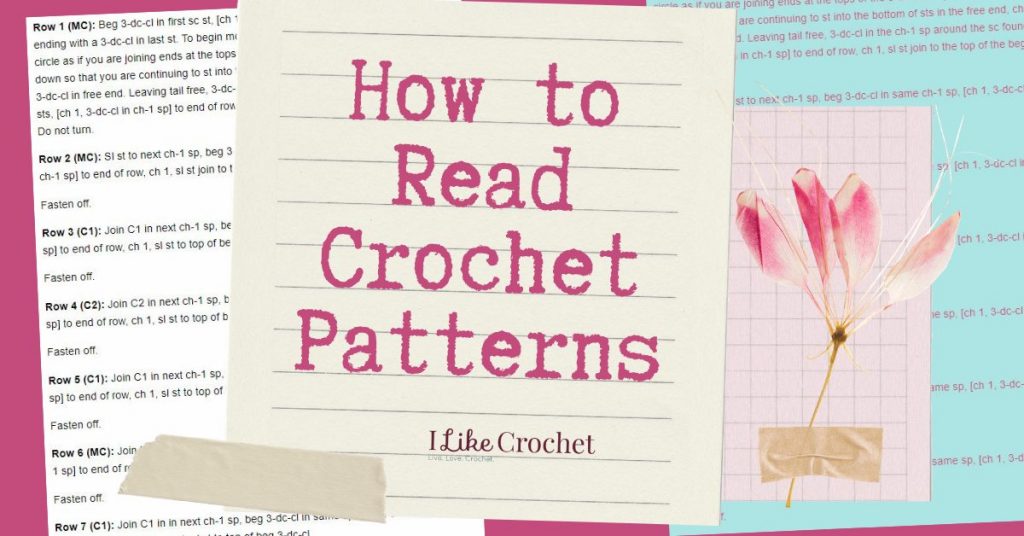
So, you’ve decided that you want to learn how to crochet – that’s great! You’ve picked out your yarn (be sure to check out How to Read a Yarn Label) and learned a few of the basic stitches, but now what? If you are just learning to crochet, one of the hurdles you must overcome is learning how to read crochet patterns. While you don’t have to learn everything all at once, there are a few important elements of a pattern to know so that you can pick up any of the patterns in this issue and feel comfortable enough to attempt them if one strikes your fancy.
Skill Level
Most patterns are given a skill level rating indicating if the pattern is easy, beginner, intermediate or advanced. Don’t let the ratings scare you, though. Read through the pattern from start to finish, and if you understand it – feel free to give it a go.
How a Pattern is Worked
Patterns are worked side to side (flat) or in the round. If you are working flat, the pattern will indicate row numbers, which row is the right side and which is the wrong side. If the pattern is worked in the round, you’ll be prompted with round numbers as your progress through the steps. When working in the round, you don’t need to worry about turning your work, but when working flat, that step is crucial at the end of rows.
Gauge
The gauge information is there for a reason! Always check your gauge – always. Trust me. Save yourself the frustration. Using the yarn and hook size indicated, work a swatch that is 4” x 4” in the stitch pattern indicated. If your gauge is not right, adjust your hook or how you hold your yarn.
Abbreviations
Before that actual pattern starts, you are given a list of the abbreviations used throughout the pattern, ones like “ch = chain” and “dc = double crochet.” These abbreviations are what make the patterns look like they are written in a foreign language. Take a little time to study this list, and soon you’ll be replacing the “ch” with “chain” as you read it in your head. We have a handy list of common and special stitch abbreviations to help you out.
Symbols
As you are learning how to read a crochet pattern you may come across some symbols such as { }, ( ), * ** and [ ]. These are important indicators on what to do while you’re working across your row.
- { } – anything inside these braces is to be repeated.
- ( ) — anything in side these parentheses is worked in the place indicated. These are also used anywhere more clarifying information about the pattern is needed (such as total stitches in a row).
- [ ] – these brackets are used interchangeably with { } and ( ) but just follow the instructions within the brackets as indicated.
- * ** – again, these indicate part of the pattern that must be repeated.
Finally, don’t start a new pattern until you have read the entire thing and understand what is happening. There’s nothing worse than starting a new pattern and getting halfway through before you realize you don’t understand what is going on.
These Beginner Crochet Patterns are a great place to start practicing your new skills.




Make sure that you know if the pattern is US or UK stitching and you know or translate before you begin.
If you are using a different yarn to your pattern, then adjust your hook size and be aware that your end product may be a different size
I am having trouble understanding the very end of my Pretty in Peplum Top directions. The finishing. Do you have a video of that part or can you explain it to me? Thanks for your help. Darlene
Like “fancy” patterns, but have trouble following a written one? Look for charted patterns– once you learn the symbols (not hard, and there usually is a list of symbols with definitions). It will SHOW what you need to do, where to place stitches, and how they are constructed. You even can “read” patterns in foreign languages you don’t speak or read, when there is a chart.
As a beginner and needing to learn the different stitches I got some yarn and made swatches of each stitch, say 20 stitches by 20 rows, knot the end and look for the next stitch to learn. By the time I ended I had enough swatches to make a sweater when I sewed them together. I’m very proud to wear what I learned.
I love your idea thank you!
Hola y muchisimas gracias por todas estas abreviaturas, explicaciones que maravilla de información, supremamente útiles. Un abrazo.
I would love to see for beginners videos of how to do the different stitches. I saw one so far but she did it so fast I ended up doing my own stitch.
Hi Joanne! I think you will like this collection of videos: https://www.ilikecrochet.com/toc/videos-back-to-basics-11-essential-techniques-and-stitches-for-every-crocheter/
Hope this helps! – Nicola, Editor
Use stitch markers in the last stitch of every row. That last stitch is easy to miss on the return row and your work will be uneven.
Self taught,,, made several baby blankets but that’s all. I know double crochet, single cr, and chain of course. So I’m a beginner.
That’s how I was so I just looked and found a pattern I wanted to try then watched You Tube videos on how to do the stitches in that particular project. Now I’m actually an advanced beginner ! Good luck on your learning !
And always check whether it is written in US or UK terminology! I’m in the UK and only a beginner and the US terms make more sense to me, however it didn’t take too long to be able to confidently convert uk patterns as I went
If you are a novice beginner, do things at first like a scarf where you can concentrate on just learning the most basic stiches (one at a time) and keeping your number of stiches the same before trying to follow patterns. Then when you master a few basic stitches, you can tackle beginner patterns without having to learn that and how to do stitches at the same time. And remember you are likely to notice mistakes no-one else will. If it’s bad enough for someone to notice, you can pretend it was a “design element” rather than a mistake. People are more impressed that you made it than whether it’s perfect.
Thank you for this helpful information
Choose a simple project: dish cloth,small scarfe…choose an easy yarn to knit/crochet with : a yarn that doesn’t get tangle…ideally a yarn for #4 or #5 crochet or needles…choose a simple pattern(beginner)& read it many X…
Be patient& expect mistakes…practice makes perfect…zoom with others for hobby…to get tips…